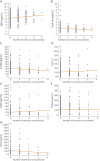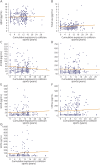Concussion BASICS II: Baseline serum biomarkers, head impact exposure, and clinical measures
- PMID: 30404782
- PMCID: PMC6282234
- DOI: 10.1212/WNL.0000000000006616
Concussion BASICS II: Baseline serum biomarkers, head impact exposure, and clinical measures
Abstract
Objective: To examine the effect of concussion history and cumulative exposure to collision sports on baseline serum biomarker concentrations, as well as associations between biomarker concentrations and clinical assessments.
Methods: In this observational cohort study, β-amyloid peptide 42 (Aβ42), total tau, S100 calcium binding protein B (S100B), ubiquitin carboxy-terminal hydrolyzing enzyme L1 (UCH-L1), glial fibrillary acidic protein, microtubule associated protein 2, and 2',3'-cyclic-nucleotide 3'-phosphodiesterase serum concentrations were measured in 415 (61% male, 40% white, aged 19.0 ± 1.2 years) nonconcussed collegiate athletes without recent exposure to head impacts. Regression analyses were used to evaluate the relationship between self-reported history of concussion(s), cumulative years playing collision sports, clinical assessments, and baseline biomarker concentrations. Football-specific analyses were performed using a modified Cumulative Head Impact Index. Clinical assessments included symptom, cognitive, balance, and oculomotor tests.
Results: Athletes with a greater number of concussions had a higher baseline Aβ42 concentration only (ρ = 0.140, p = 0.005, small effect size). No biomarker concentrations correlated with cumulative exposure to collision sports. Race status fully mediated the correlations of S100B, UCH-L1, and Aβ42 with cognitive scores. Football exposure, specifically, was not associated with serum biomarker concentrations or clinical assessment scores based on the modified Cumulative Head Impact Index.
Conclusion: Concussion-related serum biomarkers showed no consistent association with concussion history, cumulative exposure to collision sports, or clinical assessments in a sample of healthy collegiate athletes. Serum Aβ42 concentrations could increase following multiple previous concussions. Considering race status is essential when investigating links between biomarkers and cognition. The biomarkers studied may not detect residual effects of concussion or repetitive head impact exposure in otherwise asymptomatic collegiate athletes without recent exposure to head impacts. Much more research is needed for identifying reliable and valid blood biomarkers of brain trauma history.
© 2018 American Academy of Neurology.
Figures



Comment in
- Neurology. 91(23):1035.
Similar articles
-
Concussion Biomarkers Assessed in Collegiate Student-Athletes (BASICS) I: Normative study.Neurology. 2018 Dec 4;91(23):e2109-e2122. doi: 10.1212/WNL.0000000000006613. Epub 2018 Nov 7. Neurology. 2018. PMID: 30404785 Free PMC article.
-
Concussion BASICS III: Serum biomarker changes following sport-related concussion.Neurology. 2018 Dec 4;91(23):e2133-e2143. doi: 10.1212/WNL.0000000000006617. Epub 2018 Nov 7. Neurology. 2018. PMID: 30404786
-
Prospective Assessment of Acute Blood Markers of Brain Injury in Sport-Related Concussion.J Neurotrauma. 2017 Nov 15;34(22):3134-3142. doi: 10.1089/neu.2017.5046. Epub 2017 Aug 4. J Neurotrauma. 2017. PMID: 28699381 Free PMC article.
-
Use of Blood Biomarkers in the Assessment of Sports-Related Concussion-A Systematic Review in the Context of Their Biological Significance.Clin J Sport Med. 2018 Nov;28(6):561-571. doi: 10.1097/JSM.0000000000000478. Clin J Sport Med. 2018. PMID: 29035978
-
Management of concussion in soccer.Acta Neurochir (Wien). 2019 Mar;161(3):425-433. doi: 10.1007/s00701-019-03807-6. Epub 2019 Jan 28. Acta Neurochir (Wien). 2019. PMID: 30687899 Review.
Cited by
-
The Use of Biofluid Markers to Evaluate the Consequences of Sport-Related Subconcussive Head Impact Exposure: A Scoping Review.Sports Med Open. 2024 Jan 25;10(1):12. doi: 10.1186/s40798-023-00665-6. Sports Med Open. 2024. PMID: 38270708 Free PMC article.
-
Sex differences in time course and diagnostic accuracy of GFAP and UCH-L1 in trauma patients with mild traumatic brain injury.Sci Rep. 2023 Jul 22;13(1):11833. doi: 10.1038/s41598-023-38804-4. Sci Rep. 2023. PMID: 37481589 Free PMC article.
-
Interactive Effects of Racial Identity and Repetitive Head Impacts on Cognitive Function, Structural MRI-Derived Volumetric Measures, and Cerebrospinal Fluid Tau and Aβ.Front Hum Neurosci. 2019 Dec 20;13:440. doi: 10.3389/fnhum.2019.00440. eCollection 2019. Front Hum Neurosci. 2019. PMID: 31920598 Free PMC article.
-
Selected issues in sport-related concussion (SRC|mild traumatic brain injury) for the team physician: a consensus statement.Br J Sports Med. 2021 Nov;55(22):1251-1261. doi: 10.1136/bjsports-2021-104235. Epub 2021 Jun 16. Br J Sports Med. 2021. PMID: 34134974 Free PMC article.
-
Serum Protein Biomarker Findings Reflective of Oxidative Stress and Vascular Abnormalities in Male, but Not Female, Collision Sport Athletes.Front Neurol. 2020 Sep 30;11:549624. doi: 10.3389/fneur.2020.549624. eCollection 2020. Front Neurol. 2020. PMID: 33117257 Free PMC article.
References
-
- Neselius S, Zetterberg H, Blennow K, et al. . Olympic boxing is associated with elevated levels of the neuronal protein tau in plasma. Brain Inj 2013;27:425–433. - PubMed
Publication types
MeSH terms
Substances
LinkOut - more resources
Full Text Sources
Medical
Miscellaneous
